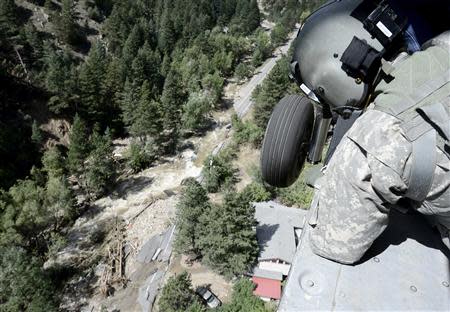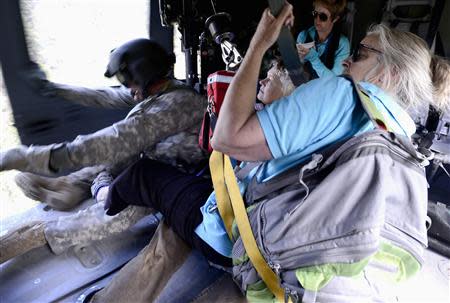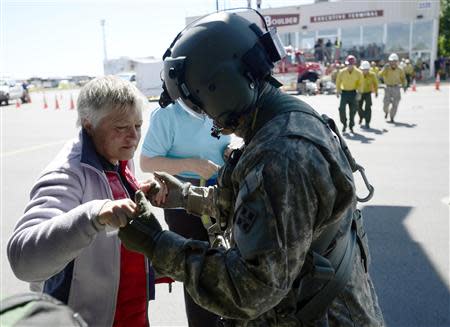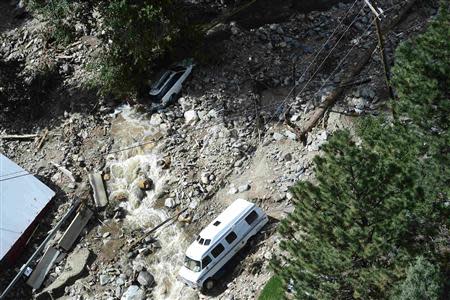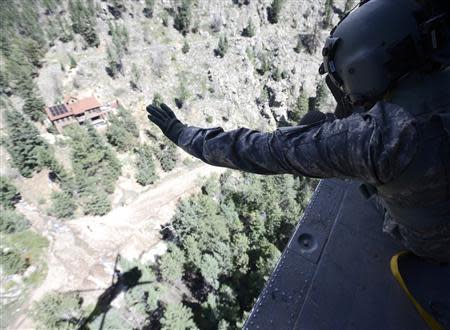Colorado evacuations continue as flood crest moves downstream
By Keith Coffman DENVER (Reuters) - Colorado officials coping with devastation from last week's torrential downpours struggled on Tuesday to reach the last pockets of known survivors left stranded by flash floods that killed least eight people in the foothills of the Rockies. Meanwhile, emergency officials pressed on with evacuations of prairie towns downstream from the initial disaster as the crest of the flood-engorged South Platte River rolled eastward toward Nebraska, inundating farmland along the way. At least 1,700 homes were destroyed - most of those in hard-hit Larimer County - and an estimated 16,300 dwellings were damaged throughout the flood zone, according to preliminary property loss totals on Tuesday. Even as evacuees continued to crowd into emergency shelters, more than 6,400 Colorado flood survivors have already applied for federal disaster assistance, the Federal Emergency Management Agency reported. In what National Weather Service meteorologists called the most sustained and intense rainstorm to hit the normally semi-arid region in four decades, a tropical-like low-pressure system drenched a 130-mile (210-km) stretch of the eastern slopes of the Colorado Rockies with unrelenting showers for a week, starting last Monday night. Within three days, torrents of runoff were gushing down rain-saturated mountainsides through canyons that funnelled floodwaters straight into populated areas below. Foothill towns clustered at the base of Colorado's so-called Front Range in Larimer and Boulder counties northwest of Denver bore the brunt of the deluge. The overall flood zone has since grown to encompass 17 Colorado counties, including the state's biggest urban centres, across a region about the size of Delaware. Efforts to reach thousands of residents cut off in communities isolated by washed-out roads and bridges were initially hampered as heavy showers persisted with little pause for seven days, grounding rescue aircraft. Except for a brief respite from the rains last Friday, when helicopters were able to fly, most of the early evacuees were ferried to safety by National Guard troops in military vehicles. HUDDLED ON A MOUNTAINSIDE Airborne rescues resumed in earnest again on Monday, and by Tuesday nearly 12,000 flood victims had been evacuated to shelters across the region, said Micki Trost, spokeswoman for the state Office of Emergency Management. "One family spent two and a half days huddled on a mountainside out of their home and were completely traumatized," said Mark Orphan, pastor of the Timberline Church in Fort Collins, which is serving as an emergency shelter. More than 1,000 evacuees had passed through the church in the week since the floods hit. Many appeared "elated" when they arrived, but others seemed dazed by their ordeals, he said. Nearly 600 more known survivors - some bedridden, elderly or in extremely hard-to-reach locations - were still awaiting rescue on Tuesday in Larimer County alone. County sheriff's spokesman John Schulz said it might be a few days more before all of them were reached. He said some people were refusing to leave their homes. Rescue operations in Boulder County, meanwhile, were winding down, emergency management officials said. However, about 300 residents from the two counties combined were still listed as unaccounted for, meaning friends or loved ones have reported receiving no word from them since the floods struck. That number has declined sharply from a few days earlier, and officials said they hoped most would turn out to be merely cut off in areas without telephone or internet service. As of Tuesday, the death toll stood at eight, including two women reported missing and presumed dead after their homes were swept away in Larimer County. But state officials revised their tally late in the day to remove them from the confirmed count of fatalities because their bodies had not been recovered. The flooding has since progressed downstream and spread out onto the prairie east of the Front Range, swamping farms, ranches and oil and gas well sites as the rain-swollen South Platte River spilled its banks. From an airplane flying over the region, vast swaths of the landscape lay hidden beneath chocolate-brown water. In one area, a small herd of black Angus cattle could be seen milling about a muddy patch of pasture surrounded by floodwaters. Above the water-logged town of Evans, a mobile home park was largely submerged, with trailers strewn about in all directions. Emergency management officials ordered the evacuation early on Tuesday of the tiny riverside town of Crook in northeastern Colorado, where firefighters went door to door asking residents to leave. The flood crest was expected to reach the larger town of Julesburg on the Nebraska border later on Tuesday. Officials there were urging ranchers to move livestock herds to higher ground. In addition to some 1,500 homes destroyed and 4,500 damaged in Larimer County, 200 businesses have been lost and 500 damaged, officials there said. Boulder County officials said rescue teams there had counted 262 homes destroyed and 290 damaged. Last week's downpour dumped up to 21 inches (53 cm) of rain in parts of Boulder city, nearly double the area's average annual rainfall. The last multi-day rainfall to spawn widespread flooding in Colorado's Front Range occurred in 1969. But a single-night deluge from a 1976 thunderstorm triggered a flash flood that killed more than 140 people in Big Thompson Canyon. (Reporting by Keith Coffman; Writing and additional reporting by Steve Gorman; Editing by Cynthia Johnston and Eric Walsh)

 Yahoo News
Yahoo News 